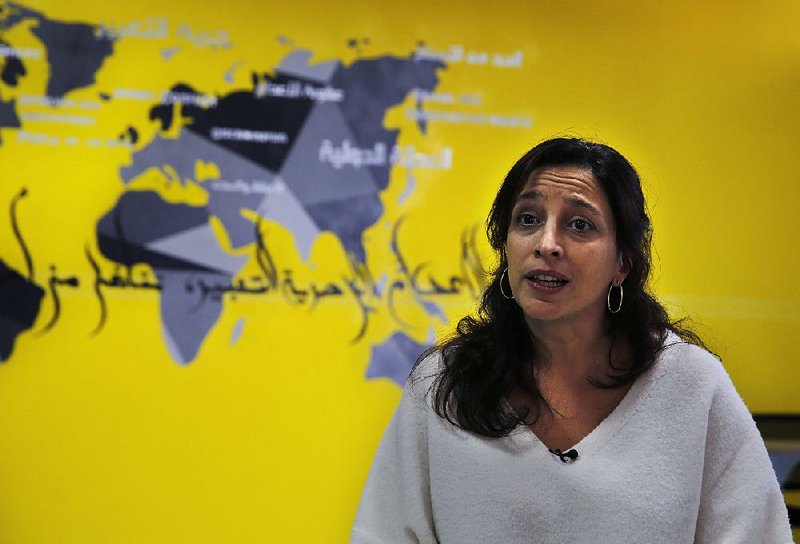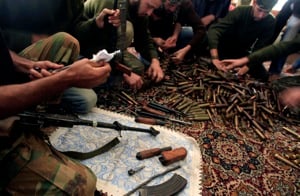BEIRUT -- The Syrian prison was known to detainees as "the slaughterhouse." Behind its closed doors, the military police hanged as many as 13,000 people over the course of four years and carted out their bodies by the truckload for burial in mass graves, according to a new report issued by Amnesty International.
The report describes in detail how the prisoners were taken out of their cells in batches of up to 50 at a time, twice a week and in the middle of the night, typically on Mondays and Wednesdays at the Saydnaya prison.
Amnesty International called it a "calculated campaign of extrajudicial execution."
The report covers the period from the start of the March 2011 uprising to December 2015, when Amnesty says between 5,000 and 13,000 people were hanged.
Amnesty said it based its estimate on testimony of 31 former prisoners, four prison officials and three judges familiar with specific instances of the executions and the frequency with which they appeared to occur. They are identified in the report only by their last names because of concerns for their safety.
"We now know where, when and how often these hangings are taking place, as well as which elements of the Syrian government have authorized them," said Nicolette Waldman, an Amnesty researcher specializing in detention issues and one of the report's authors.
The majority of those executed at Saydnaya were political prisoners, including many of the ordinary people who joined in the peaceful protests against Syrian President Bashar Assad, the report says. Some were rebels who took up arms, and others were officers and soldiers who had defected from government forces. But for the most part they were "doctors, engineers, protesters," one former prison official is quoted as saying. "They were somehow understood to be linked to the revolution. Saydnaya is the place to finish the revolutionaries. It's the end for them."
They were given only cursory trials lasting between one and three minutes at one of two military field courts that offered no semblance of judicial process, with sentences typically handed down on the basis of confessions extracted under torture. When the time came for execution, the prisoners were handcuffed, blindfolded and led to a basement cell containing 10 stands and 10 nooses.
A former judge from the military court described the executions, saying it would often take up to 10-15 minutes for the prisoners to die. "Some didn't die because they are light. For the young ones, their weight wouldn't kill them. The officers' assistants would pull them down and break their necks. Two officers' assistants were in charge of this."
Amnesty said the executions "amount to war crimes and crimes against humanity" and are authorized at the highest levels of the Syrian government.
Lynn Maalouf, deputy director for research at Amnesty's regional office in Beirut, said there is no reason to believe that the practice has stopped since then, with thousands more probably killed.
Amnesty said the killings were authorized by senior Syrian officials, including deputies of Assad.
"The horrors depicted in this report reveal a hidden, monstrous campaign, authorized at the highest levels of the Syrian government, aimed at crushing any form of dissent within the Syrian population," Maalouf said.
"These executions take place after a sham trial that lasts over a minute or two minutes, but they are authorized by the highest levels of authority," including the grand mufti, a top religious authority in Syria, and the defense minister.
There was no immediate comment Tuesday from the Syrian government, and Amnesty said Damascus didn't respond to its own letter seeking comment. Syrian government officials rarely comment on allegations of torture and mass killings. In the past, they have denied reports of massacres documented by international human-rights groups, describing them as propaganda.
U.N. chief 'horrified'
The Amnesty report prompted a strong reaction from United Nations Secretary-General Antonio Guterres, who "was horrified about what was in the report," according to U.N. spokesman Stephane Dujarric.
"We have repeatedly raised serious concerns about the grave violations of international human rights and international humanitarian law in Syria, including in detention centers and government-run prisons," Dujarric said at U.N. headquarters in New York. "What is important is that there needs to be accountability for all the victims in this conflict."
Amnesty had recorded at least 35 methods of torture in Syria since the late 1980s, practices that only increased since 2011, Maalouf said.
Other rights groups have found evidence of widespread torture leading to death in Syrian detention facilities. In a report last year, Amnesty found that more than 17,000 people have died of torture and ill-treatment in custody across Syria since 2011, an average rate of more than 300 a month.
Those figures are comparable to battlefield deaths in Aleppo, one of the fiercest war zones in Syria, where 21,000 were killed across the province since 2011.
Saydnaya has become the main political prison in Syria since 2011, according to a former official interviewed by Amnesty. A former guard said it held "the detainees of the revolution," and a former judge said they were seen as "posing a real risk to the regime."
The chilling accounts in Tuesday's report came from interviews with 31 former detainees and more than 50 other officials and experts, including former guards and judges.
Detainees were told they would be transferred to civilian detention centers but were taken instead to another building in the facility and hanged.
"They walked in the 'train,' so they had their heads down and were trying to catch the shirt of the person in front of them. The first time I saw them, I was horrified. They were being taken to the slaughterhouse," Hamid, a former detainee, told Amnesty.
Some prisoners stood on toilets to look out windows and saw bodies carted away and the slippers left lying on the ground. "If there were 30 slippers, then we knew that 15 people had been executed," Abu Osama, a former military officer detained in the prison, was quoted as saying. "There were usually between 30 and 80 slippers outside."
Another former detainee, Omar Alshogre, said the guards would arrive at his cell, sometimes three times a week, and call out detainees by name.
Alshogre, 21, who spent nine months in Saydnaya and now lives in Sweden, said he would hear detainees being tortured. "Then the sound would stop," he said.
He described how at times he was forced to keep his eyes closed and his back to the guards while they abused or suffocated a cellmate. The body often would be left behind, or there would be a pool of blood in the cell for other prisoners to clean up.
The Amnesty report contains similar accounts of abuse.
"Many of the prisoners said they were raped or in some cases forced to rape other prisoners. Torture and beatings are used as a regular form of punishment and degradation, often leading to life-long damage, disability or even death," the report says. "The cell floors are covered with blood and pus from prisoners' wounds. The bodies of dead detainees are collected by the prison guards each morning, around 9am."
Amnesty quoted a former guard as saying, "We already know they will die anyway, so we do whatever we want with them."
The detainees were transported to trials in vans known as "meat fridges" and would not be informed of their fate until just before they were hanged, officials who witnessed the executions told Amnesty.
Medics usually would list the cause of death as "heart stopped" or "breathing stopped," before the bodies were taken to mass graves near Damascus.
Information for this article was contributed by Sarah El Deeb and Edith Lederer of The Associated Press; by Liz Sly of The Washington Post; and by Anne Barnard of The New York Times.
A Section on 02/08/2017

